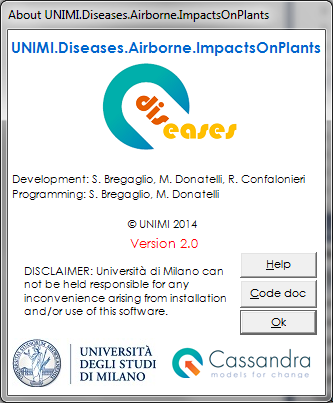OBJECTIVE
The ImpactsOnPlants component contains models to simulate the impact of a plant epidemic on leaf area evolution and biomass growth, via the coupling to crop models.

Form about of the ImpactsOnPlants component
RATIONALE
The assessment of crop yield losses is the raison d'etre of plant pathology (e.g., Fargette et al., 1988; Savary and Cooke, 2006). The available approaches to simulate the yield losses due to foliar diseases can be grouped into three main categories (Madden and Nutter, 1995): single and multiple point models, which compute the percentage of yield loss via empirical relationships with the disease incidence or severity; integral models, which estimate crop losses as a function of the epidemic development, usually as a function of the Area Under the Disease Progress Curve (AUDPC); process based approaches, which reproduce the damage of the disease on crop organs or growth processes by linking the outputs of disease models with crop simulators (Pinnschmidt et al., 1995). The latter approach allows a more realistic simulation of the crop-pathogen interactions (Johnson and Teng, 1990), thanks to the incorporation of the epidemic evolution into the crop growth dynamics via coupling points, reproducing the impacts of the disease on plant physiological processes (Boote et al., 1983). The mechanisms of damage of fungal foliar pathogens can be grouped into two broad categories: the impacts on radiation interception, and the impacts on the photosynthetic activity (Johnson, 1987).
Created with the Personal Edition of HelpNDoc: Full-featured EPub generator